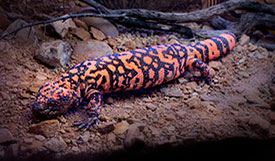Office of Research & Development |
 |
Office of Research & Development |
 |
May 7, 2019

The venom of the Gila monster, pictured here in Saguaro National Park in Arizona, was the source for a diabetes drug discovered by VA researchers. (Photo: ©iStock/Jay Pierstorff)
VA researchers discovered a new diabetes drug from an unusual source. In the mid 1990s, Drs. John Eng and Jean-Pierre Raufman found that a hormone in the venom of the Gila monster—a large lizard native to the southwestern United States—stimulates the body’s insulin production. The hormone, exendin-4, works similar to another hormone called GLP-1 found in the digestive tract in humans that regulates blood glucose. But exendin-4 degrades in the body much slower than GLP-1.
Eng licensed the discovery to an outside pharmaceutical company so it could be developed into a drug. A synthetic version of exendin-4, called exenatide, was approved for medical use by the FDA in 2005. Exenatide, sold commercially as Byetta or Bydureon, is taken as a shot by people with Type 2 diabetes. It is used as an add-on to other diabetes drugs to avoid or postpone the use of insulin injections when diabetes is not well-controlled by the primary medicine. More than 2 million people now use exenatide worldwide.
Principal investigator: John Eng, M.D., James J. Peters VA Medical Center; Jean-Pierre Raufman, M.D., Baltimore VA Medical Center (formerly with State University of New York Health Science Center)
Selected publications:
Isolation and characterization of exendin-4, an exendin-3 analogue, from Heloderma suspectum venom. Eng J, Kleinman WA, Singh L, Singh G, Raufman JP. Journal of Biological Chemistry. 1992;267(11):7402-7405.
Bioactive peptides from lizard venoms. Raufman JP. Regul Pept. 1996 Jan 16;61(1)1-18.
Lizard-linked therapy has roots in the Bronx. New York Times. Sept. 21, 2002.
Dr. John Eng’s research found that the saliva of the Gila monster contains a hormone that treats diabetes beter than any other medicine. Diabetes in Control. Sept. 18, 2007.